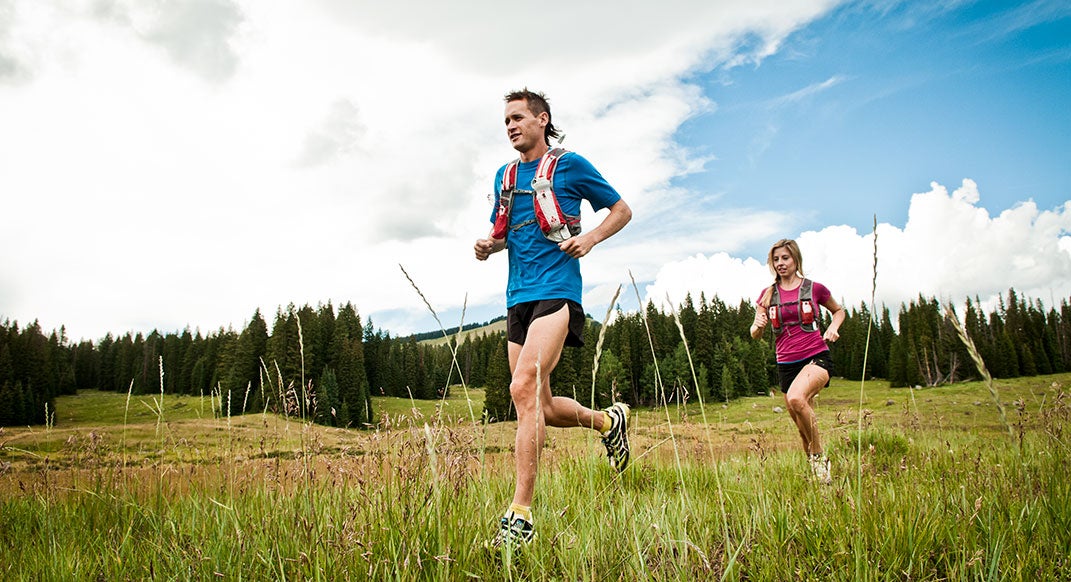How To Hydrate For Better Trail Running

It’s 3:00 p.m. on a Sunday. You’ve been out for an hour or so, ticking off the miles and feeling pretty good. Then, all of a sudden, your face turns into a giant, dripping sweat faucet. Your mouth feels like it’s coated with cotton-ball fluff. You reach for the hose of your hydration bladder … but nothing comes out. Empty.
As trail runners, hydration is one of our most basic needs. We talked to some of the sport’s leading coaches and athletes for their advice on how to stay properly hydrated on the trail.
Before your workout
Hydrate well before a run, and you can often leave the handheld at home. “If you start every run nice and hydrated, you don’t even need to bring a drink on any runs shorter than 90 minutes,” says coach and Trail Runner contributing editor David Roche. “Unless you have trained without fluids, in which case you can probably go up to two hours before you need to start bringing drinks along.”
Of course, that doesn’t mean you should binge on fluids before longer runs. “There is no need to stock up on liquids,” says ultrarunning coach Ian Sharman. “This can lead to bloating and needing to urinate regularly in the early stages of the run.”
Electrolytes and calories
The primary concern on longer runs, says Sharman, is the depletion of the body’s energy reserves. The focus, then, should be calorie, rather than electrolyte, replenishment.
“If you plan to eat on your long run, then additional electrolyte drink mixes are superfluous,” he says. Whether in the form of sports drink, gels, bars or “real” foods, most calorie sources will contain enough sodium to replenish what you’ve lost through sweat. For shorter runs that won’t seriously deplete your energy reserves, plain old water is fine.
If you do plan to use a carbohydrate or electrolyte drink mix, make sure to use it in training before race day.
RELATED: Ask The Coach: How Much Should I Hydrate During My Run?
Volume and frequency
Ultrarunning coach Jason Koop recommends taking a drink every 15 minutes. Similarly, Roche advises a benchmark of 20 to 24 ounces of liquid per hour.
Ian Sharman goes by an even simpler equation. “Drink when you are thirsty,” he says. “Use training runs as a way to get a sense of how much fluid your body needs in different conditions and at different effort levels.”
Temperature
Whatever your body’s hydration needs are, they will likely increase when it gets hotter out. Still, that doesn’t mean they become negligible when temperatures drop. “You might feel like you aren’t losing much sweat” in colder weather, says Roche, “but don’t cut your fluid intake too much.” You are still dehydrating, even if you can’t feel it.
Overhydration
Drinking too much is at least as common as drinking too little, according to coaches. Overhydration can lead to uncomfortable bloating and hyponatremia, or below-normal blood-sodium levels, a potentially serious condition.
Symptoms of hyponatremia, according to Sharman, include “nausea and vomiting, headache, short-term memory loss, confusion, lethargy, fatigue, loss of appetite, irritability, muscle weakness, spasms or cramps, seizures and decreased consciousness or coma.”
RELATED: How To Fuel Properly In The Cold
Misdiagnosis
If you think you are dehydrated, those symptoms may actually point to something else. “A runner who starts to feel very hot, gets dizzy and looks redder than usual is much more likely to be overheating,” says Sharman. While dehydration can be addressed by drinking more liquids, the remedy for overheating is to soak the body in cold water and ice. Downing cold fluids won’t help (and could actually cause you to overhydrate).
After your workout
Your hydration duties don’t stop when your run does. In fact, Sharman explains, athletes should be paying attention to their fluid intake for as much as one full day after a run.
“During the course of a day, most people don’t think about drinking every time they’re thirsty,” he says. “But the body needs adequate liquids and nutrition to rebuild muscle and recover as quickly as possible.”
There’s no need to force-feed yourself gallons of recovery powder. Just keep things simple and a take few sips of something whenever your body tells you it needs it.